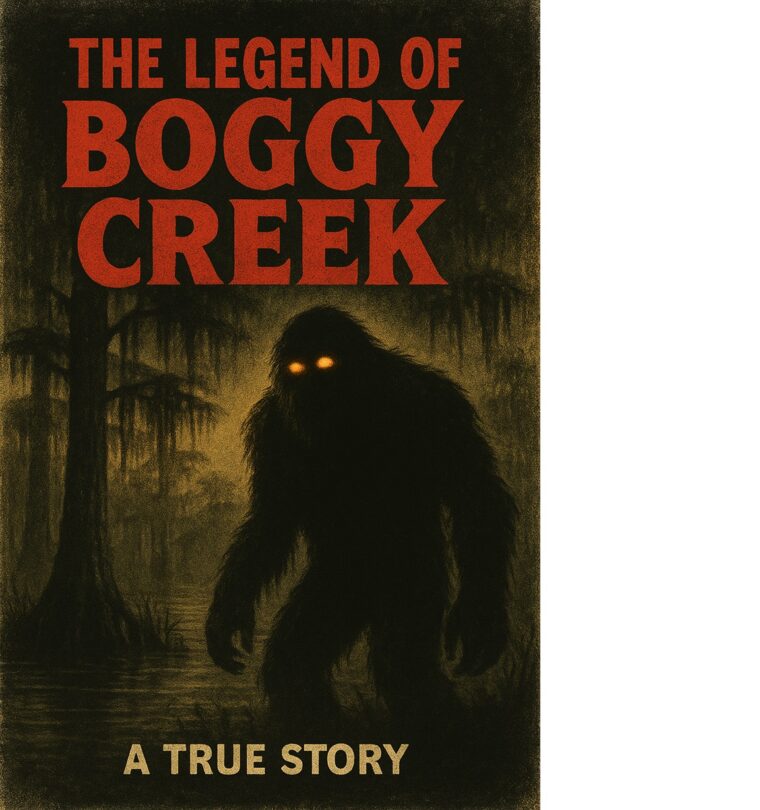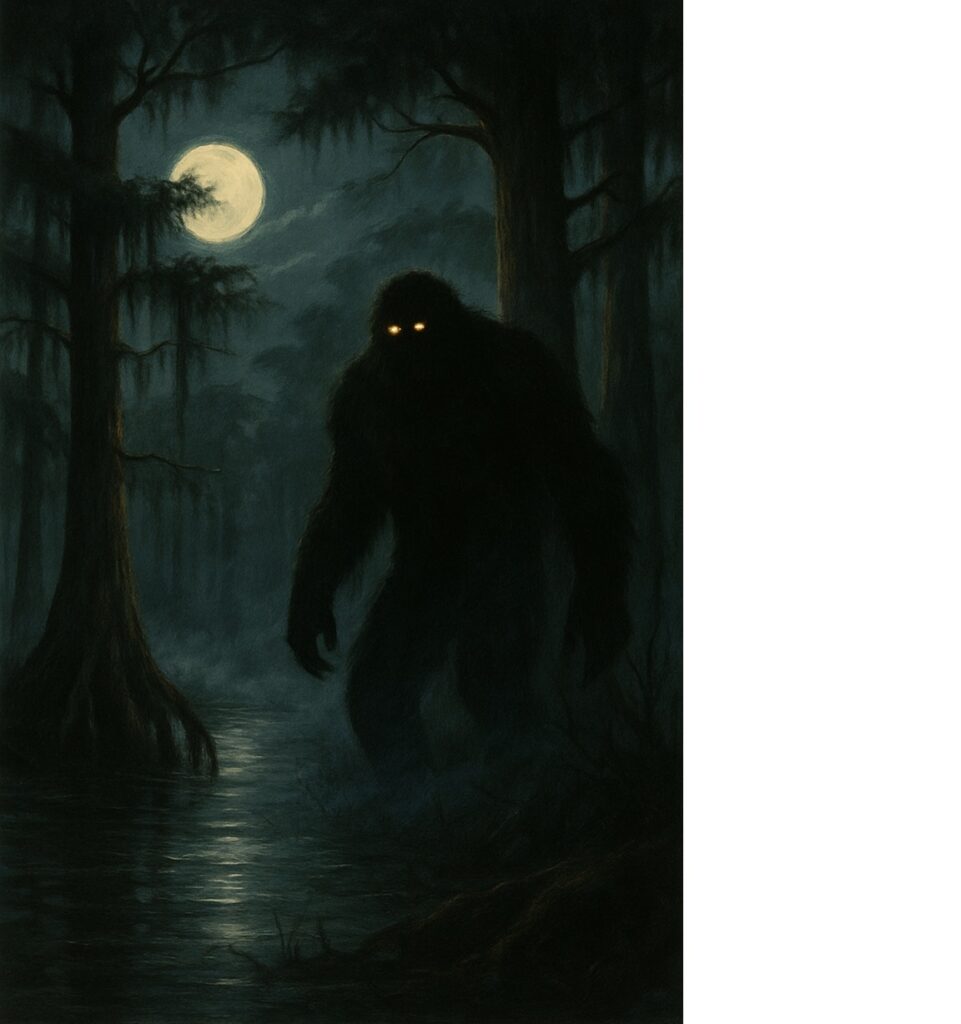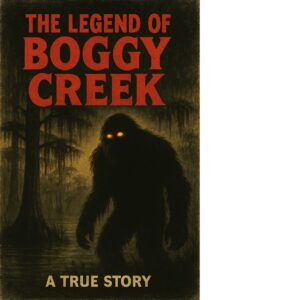The Legend of Boggy Creek: Uncovering the Mystery of the Fouke Monster
In the heart of southern Arkansas lies a tale that has captivated monster hunters, moviegoers, and curious minds for over five decades. The Legend of Boggy Creek isn't just a film; it's a living piece of folklore that blurs the line between myth and reality. The story of the Fouke Monster—a Bigfoot-like creature said to roam the swampy lowlands near the town of Fouke—has become synonymous with cryptid culture in America. From eerie eyewitness accounts to its enduring pop culture presence, this legend continues to intrigue and mystify.
Let’s take a deep dive into the shocking truth behind The Legend of Boggy Creek—where it all began, what the monster might be, and why it remains one of America’s most enduring mysteries.
Origins of The Legend of Boggy Creek
Historical sightings before the film
Long before The Legend of Boggy Creek hit theaters in 1972, locals in and around Fouke reported terrifying encounters. Stories of a hairy, bipedal creature date back to the early 1900s, with frequent reports intensifying during the 1940s and 1950s. Farmers spoke of livestock disappearing, dogs barking frantically at unseen threats, and strange howls echoing through the night.
One of the most famous pre-film incidents occurred in 1971, when the creature allegedly attacked the home of Bobby and Elizabeth Ford. The couple claimed the beast tried to break into their house late at night, leaving claw marks on the porch and terrifying the family. The media picked up the story, and soon, monster fever gripped the region.
Charles B. Pierce and the creation of the film
Charles B. Pierce, a regional advertising executive and filmmaker, saw an opportunity in the local legend. He decided to create a movie blending documentary-style narration with dramatized re-enactments of supposed encounters. Operating on a shoestring budget of around $100,000, Pierce filmed on location in Fouke and used non-professional actors—many of them locals—to add authenticity.
The result was a chilling, atmospheric film that felt more like a true-crime documentary than a work of fiction. The eerie, grainy footage and haunting soundtrack gave the impression that The Legend of Boggy Creek was recounting real, terrifying events.
The Fouke Monster: Arkansas’ Bigfoot?
Physical descriptions from eyewitnesses
The Fouke Monster is typically described as a large, hairy creature standing between 6 and 8 feet tall. Witnesses say it’s covered in dark brown or reddish fur, emits a foul odor, and has piercing red eyes that glow in the dark. The creature walks upright and leaves massive three-toed footprints, unlike the five-toed prints associated with Bigfoot.
Its cry is said to be a terrifying mix of a woman’s scream and a panther’s roar—a sound that chills those who hear it to the bone.
Comparison to other cryptids (Bigfoot, Skunk Ape)
Many researchers and enthusiasts compare the Fouke Monster to other legendary cryptids like Bigfoot of the Pacific Northwest or the Skunk Ape of Florida. While similarities abound, the Fouke Monster’s distinct three-toed tracks and swamp habitat set it apart.
Some believe these regional variations represent different species of an unknown primate, while skeptics argue they reflect local folklore adapting to its environment.
The 1972 Film That Started It All
Low-budget masterpiece or exploitation?
Pierce’s film became a surprise hit, grossing over $20 million nationwide despite its modest budget. Some critics praised its innovative style, blending horror with documentary realism. Others saw it as exploitative, capitalizing on rural fears and folklore.
Regardless of opinion, the film’s success sparked a wave of interest in the Fouke Monster and inspired a generation of low-budget creature features.
Critical reception and box office success
While major critics largely ignored The Legend of Boggy Creek, regional newspapers and genre fans lauded its eerie atmosphere and realism. Drive-ins and small-town theaters filled with audiences eager to be scared, and the film’s success helped Pierce launch a career in filmmaking.
The Setting: Fouke, Arkansas
Geography and environment of Boggy Creek
Fouke, Arkansas, is a small rural town nestled in the southwest corner of the state, near the Texas border. The area is characterized by its dense forests, winding creeks, and expansive swamplands, particularly the Sulphur River bottoms. These murky waterways and shadowy woods create the perfect backdrop for tales of hidden creatures lurking just out of sight.
Boggy Creek itself, with its slow-moving waters and thick underbrush, is both beautiful and eerie. The isolation and wildness of the region have long fueled the imagination of locals and visitors alike, giving rise to legends like that of the Fouke Monster.
Why the area fueled monster stories
It’s no wonder that a place as untamed as Fouke would inspire stories of mysterious beasts. The remoteness of the terrain means that it’s easy for strange sounds and fleeting shadows to play tricks on the mind. Add in the region’s rich tradition of storytelling, and you have fertile ground for a legend to take root.
Hunters, fishermen, and farmers spending long nights outdoors would often swap tales of what they’d seen—or thought they’d seen—near Boggy Creek, passing down the legend through generations.
The Impact on Pop Culture
References in TV, music, and literature
The Legend of Boggy Creek has left a lasting mark on American pop culture. The Fouke Monster has appeared in TV shows like MonsterQuest and Finding Bigfoot, as well as in documentaries about cryptids and unexplained phenomena. Musicians, too, have paid homage; country and folk artists have penned songs inspired by the legend.
The creature even makes appearances in fiction, from novels to comic books, often portrayed as a symbol of the untamed American wilderness.
Influence on other monster movies
Pierce’s film helped pioneer a subgenre of creature features that blend fact and fiction. Its success showed that audiences craved stories that felt real, paving the way for films like Blair Witch Project and Willow Creek. Many low-budget filmmakers cite The Legend of Boggy Creek as a major influence on their work, praising its ability to terrify without relying on elaborate effects.
Sequel Films and Spin-offs
Boggy Creek II and The Legend Continues
In 1985, Charles B. Pierce returned to the swampy setting with Boggy Creek II: And the Legend Continues. The sequel follows a fictional professor and his students as they investigate the creature. While it failed to capture the eerie magic of the original, it gained cult status over time for its campy charm and earnestness.
Other unofficial sequels and reboots
Over the years, various filmmakers have attempted to cash in on the legend with unofficial sequels, reboots, and inspired-by films. Titles like Return to Boggy Creek (1977) and Boggy Creek: The Legend Is True (2010) tried to rekindle the fear the original instilled, with varying degrees of success.
The Legend’s Role in Local Tourism
Annual festivals and tours
Fouke has embraced its most famous resident. The town hosts annual festivals celebrating the Fouke Monster, complete with guided tours, reenactments, and cryptid merchandise. Visitors can explore Boggy Creek by boat or on foot, hoping to catch a glimpse of the creature—or at least hear its legendary howl.
These events attract cryptid enthusiasts, paranormal investigators, and curious tourists from across the country.
Local businesses built on the legend
From souvenir shops selling Fouke Monster T-shirts to themed diners and museums, the legend has become an economic boon for this small community. The Monster Mart, a local convenience store turned museum and gift shop, is a must-visit for anyone eager to learn more about the legend and see castings of alleged footprints.
Eyewitness Testimonies Over the Years
Famous encounters and reports
Beyond the infamous Ford sighting, dozens of people have claimed encounters with the Fouke Monster. Accounts range from fleeting glimpses of a shadowy figure to close encounters that left property damaged and witnesses shaken. In the 1990s and 2000s, new reports surfaced, keeping the legend alive for a new generation.
Skeptics vs believers
As with any cryptid tale, there’s a divide between those who believe in the Fouke Monster and those who seek rational explanations. Skeptics point to misidentified wildlife, pranks, or exaggerations fueled by folklore. Believers argue that the consistency of descriptions over decades suggests something more than mere myth.
Scientific Investigations of the Fouke Monster
Cryptozoologists' studies
Cryptozoologists have long been fascinated by the Fouke Monster. Expeditions to the region have yielded footprint casts, audio recordings of strange calls, and firsthand witness interviews. While no conclusive proof has emerged, these studies have added to the legend’s mystique and kept interest alive.
Academic views on the legend
Mainstream scientists generally regard the Fouke Monster as a product of folklore and misidentification. However, sociologists and folklorists find the legend a rich subject for studying how communities create and sustain mythologies. The Fouke Monster, they argue, reflects deeper cultural fears and a longing for mystery in an increasingly mapped and explained world.
The Psychology of Monster Legends
Why humans create cryptid stories
Since the dawn of time, humans have spun tales of beasts lurking beyond the campfire’s glow. Stories like The Legend of Boggy Creek serve many purposes. They can explain the unexplainable, give form to our fears, or simply entertain. In rural areas like Fouke, where isolation and untamed wilderness foster uncertainty, these legends help people make sense of strange sights and sounds in the night.
There’s also a communal element. Sharing monster stories strengthens community bonds, offering shared experiences and a sense of identity rooted in local lore.
Mass hysteria or cultural folklore?
Some experts suggest that mass hysteria could account for the surge in Fouke Monster sightings during certain periods. When one report makes headlines, it primes others to interpret ordinary events—like a rustling bush or a fleeting shadow—as evidence of the creature.
But whether due to hysteria or folklore, the result is the same: the legend grows stronger, passed down from generation to generation.
The Soundtrack and Atmosphere of the Film
Music’s role in building fear
The haunting score of The Legend of Boggy Creek is part of what makes the film so memorable. Simple guitar melodies, somber ballads, and eerie sound effects heighten the sense of dread. The music underscores the isolation of the characters and the menace of the unseen monster lurking just beyond the trees.
The haunting narration style
Narration in the film, delivered in a low, serious tone, adds to its documentary feel. It gives viewers the impression that they’re watching a true account of real events. This storytelling technique, combined with the grainy visuals, makes the film feel like a window into an authentic rural nightmare.
Filming Challenges and Production Secrets
Real locations used in the film
Pierce insisted on filming in and around Fouke, using real swamp and forest locations to lend authenticity. The decision brought its own challenges: cast and crew battled mosquitoes, heat, and the ever-present threat of snakes and other wildlife. But the payoff was a film steeped in atmosphere, where the setting itself became a character.
Casting local townsfolk as actors
Rather than hire professional actors, Pierce turned to the residents of Fouke and nearby towns. This choice enhanced the film’s realism and kept production costs low. The result was performances that, while unpolished, felt genuine—ordinary people caught in extraordinary circumstances.
Debunking the Legend: What Could the Monster Be?
Possible animal explanations
Skeptics propose that sightings of the Fouke Monster could be misidentifications of known animals. Black bears, in particular, can stand upright and emit strange sounds. Wild boars, large dogs, and even escaped exotic pets have also been suggested as explanations for the creature.
The three-toed tracks? Some researchers believe these were hoaxes or the result of eroded prints left by more mundane animals.
Hoaxes and misidentifications
Over the years, pranksters have admitted to faking evidence, including footprints and eerie sounds, to keep the legend alive or simply to stir up excitement. Yet, despite these confessions, the monster’s mythos endures—proof of the power of a good story.
The Legend’s Legacy in 2025
How the story endures today
More than 50 years after the film’s release, The Legend of Boggy Creek continues to fascinate. New documentaries, podcasts, and YouTube channels explore the Fouke Monster, revisiting old cases and searching for fresh clues. The legend has become a permanent part of America’s cryptid canon, inspiring curiosity and debate in equal measure.
Modern media revivals
Recent years have seen a resurgence of interest in the legend, with filmmakers and authors revisiting the story for modern audiences. Streaming platforms offer remastered versions of the original film, and indie creators produce fresh takes on the monster’s tale. The Fouke Monster, it seems, is as enduring as the forests it’s said to haunt.
Frequently Asked Questions about The Legend of Boggy Creek
Where can I watch The Legend of Boggy Creek?
The original film can be found on DVD, Blu-ray, and select streaming services. Some platforms, like Tubi or Amazon Prime Video, may offer it for free or rent.
Is the Fouke Monster real?
There’s no scientific evidence confirming the creature’s existence. Most experts believe the Fouke Monster is a product of folklore, misidentifications, or hoaxes.
What inspired the movie?
The film was inspired by local reports of a large, hairy creature seen around Fouke, Arkansas, particularly a highly publicized 1971 encounter.
How accurate is the film?
While based on alleged events, the film takes creative liberties and dramatizes incidents for effect. It blends fact, fiction, and folklore to create a chilling narrative.
Are there recent sightings?
Occasional reports still emerge of strange creatures or sounds in the Fouke area, but no recent evidence has verified these claims.
Is Fouke, Arkansas safe to visit?
Absolutely. Fouke is a peaceful rural community that welcomes visitors, especially those interested in the legend. Just be respectful of private property and local customs.
Conclusion: The Enduring Allure of The Legend of Boggy Creek
The Legend of Boggy Creek endures because it taps into something primal—our fear of the unknown, our love of a good mystery, and our fascination with the wild places on the edge of civilization. Whether the Fouke Monster is real or not, the legend has become an indelible part of American folklore. It reminds us that sometimes, the scariest things aren’t the monsters themselves, but the stories we tell about them.



